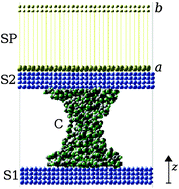Force exerted by a nanoscale capillary water bridge between two planar substrates
Abstract
Molecular dynamics simulation of a nanoscale capillary water bridge between two planar substrates is used to determine the resulting force between the substrates without arbitrariness regarding geometry and location of the free surface of the bridge. The substrates are moderately hydrophilic. The force changes continuously as the separation between the substrates changes except for small gaps where it becomes discontinuous because the bridge is unable to adopt stable configurations at any distance apart. Further exploration of the bridge and the force as the substrates approach each other reveals an underlying oscillatory force with an increasing repulsive component at separation distances equivalent to few water molecules. According to the average number of hydrogen bonds per water molecule (HBN), at very small gap sizes, water molecules which are very close to the surfaces are unable to maximize HBN thus contributing to the repulsive force. Our simulation results of force versus gap size agree with calculations based on other methods, some very different, and also reproduce the typical magnitude of the experimental force. Finally, a macroscopic force balance correctly describes the force–distance curve except for bridges constituted of water layers only.


 Please wait while we load your content...
Please wait while we load your content...